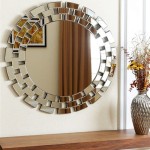Hanging Heavy Mirrors Without Studs: A Comprehensive Guide
Hanging a heavy mirror can be a daunting task, especially when faced with the absence of wall studs. While studs offer the most secure anchoring point, various alternative methods provide reliable support for substantial mirrors, even on drywall or plaster surfaces. Choosing the right method depends on several factors, including the mirror's weight, the wall's construction, and the desired aesthetic.
Understanding Wall Anchors
Wall anchors are essential for hanging heavy objects on walls without studs. They distribute the weight over a larger area, reducing stress on the wall material and providing a secure hold. Several types of wall anchors are available, each suited to specific applications:
*
Toggle Bolts:
These anchors are ideal for hollow walls and provide exceptional holding power. They consist of a bolt and a spring-loaded toggle that expands behind the wall, distributing the weight. *Molly Bolts:
Similar to toggle bolts, molly bolts also work well in hollow walls. They use a metal sleeve that expands when the bolt is tightened, creating a secure grip. *Plastic Expansion Anchors:
These anchors are suitable for lighter weights and solid walls. They expand as a screw is driven into them, wedging themselves against the wall material. *Self-Drilling Drywall Anchors:
Convenient for quick installations, these anchors feature a sharp point that allows them to be drilled directly into drywall without pre-drilling a hole. However, they are generally less suitable for very heavy items.Choosing the Right Anchor for Your Mirror
Selecting the appropriate anchor depends primarily on the weight of the mirror. Always consult the anchor packaging for its weight rating and choose an anchor rated significantly higher than the mirror's actual weight. Overestimating the weight ensures a safety margin. The wall material also plays a role; toggle bolts and molly bolts are better suited for hollow walls, while plastic expansion anchors generally perform better in solid walls. Consider the thickness of the wall as well, as longer anchors are required for thicker walls.
Preparing the Wall Surface
Before installing any anchor, ensure the wall surface is clean and free of debris. Mark the desired location for the mirror carefully using a level and a pencil. Measure the distance between the hanging hardware on the back of the mirror to ensure accurate placement of the anchors. Precise measurements are crucial for a level and securely hung mirror.
Installing the Wall Anchors
Follow the manufacturer’s instructions for installing the chosen anchor. Generally, this involves drilling a pilot hole of the appropriate size, inserting the anchor, and then tightening the screw or bolt until the anchor is firmly secured. For toggle bolts, ensure the toggle wings are fully expanded behind the wall before tightening the bolt. For molly bolts, ensure the sleeve is completely compressed against the wall. Proper installation is crucial for ensuring a secure and long-lasting hold.
Using Adhesive Solutions: Mirror Mastic
For heavier mirrors, mirror mastic offers an alternative to traditional wall anchors, especially on solid surfaces like tile or concrete. Mirror mastic is a strong adhesive specifically designed for bonding mirrors to walls. It provides a large bonding area, distributing the weight evenly and offering excellent support. However, it is essential to follow the manufacturer’s instructions carefully, as proper application is crucial for successful adhesion.
Applying Mirror Mastic Correctly
*
Surface Preparation:
Clean the wall surface thoroughly to ensure proper adhesion. A clean, dry surface is vital for successful bonding. *Mastic Application:
Apply the mastic in vertical beads to the back of the mirror, following the manufacturer’s recommended spacing. Avoid applying the mastic too close to the edges of the mirror to prevent squeeze-out. *Positioning and Support:
Carefully position the mirror on the wall and apply firm, even pressure. Use temporary supports, such as painter’s tape or wooden blocks, to hold the mirror in place while the mastic cures. *Curing Time:
Allow the mastic to cure completely according to the manufacturer’s instructions before removing any temporary supports. Sufficient curing time is crucial for developing maximum bond strength.Combining Methods for Extra Security
For extremely heavy mirrors, combining methods can provide added security. For instance, using both heavy-duty wall anchors and mirror mastic can offer a robust and reliable hanging solution. This approach distributes the weight across both the anchors and the adhesive, minimizing stress on any single point and ensuring a secure hold.
Safety Precautions
When hanging heavy mirrors, prioritize safety. Wear appropriate safety glasses to protect your eyes from dust and debris during drilling. Use a stud finder to locate any existing wall studs that could be used for additional support. Always have a helper assist with lifting and positioning heavy mirrors to prevent accidents and injuries. A stable work platform is also essential to prevent falls while working at height.
How To Hang A 100 Pound Mirror On Drywall Quora

How To Hang Heavy Wall Decor Green With

How To Hang A Heavy Mirror

How To Hang Heavy Items Without A Stud

How To Hang A 31kg Mirror On Wall With Bunnings Work Community

How To Hang A Heavy Mirror

How To Hang A Heavy Mirror
How To Hang A 100 Pound Mirror On Drywall Quora

How To Hang A Heavy Mirror The Home Depot

How To Hang Heavy Mirrors Frames Without Nails 3m








